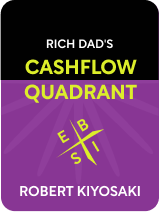

This article is an excerpt from the Shortform book guide to "Rich Dad's Cashflow Quadrant" by Robert T. Kiyosaki. Shortform has the world's best summaries and analyses of books you should be reading.
Like this article? Sign up for a free trial here .
Why is working for money no longer secure? What are the dangers of relying on employment to generate income?
According to Robert Kiyosaki, working for money is no longer a safe bet for financial security, much less financial freedom. He says that people who generate income from the work they do (employees, self-employed, and small business owners) are at a much higher risk today than they were in the past because of the economic changes that took place over the past half-century.
Here is what’s wrong with working for money, according to Kiyosaki.
Editor’s note: This article is part of Shortform’s guide to saving money. If you like what you read here, there’s plenty more to check out in the guide!
Robert Kiyosaki: Working for Money Is a Trap
According to Kiyosaki, there are four general ways of generating income: as an employee (E), as a self-employed person or a small business owner (S), as a large business owner (B), and as an investor (I).
In the E and S categories, you are working for money and sacrificing freedom for security. In the B and I categories, you generate income by owning assets.
Kiyosaki says that working for money is no longer a secure way to generate income (more so, in the E category). Other than the financial trap the E job will land you in, Kiyosaki says the disadvantages of an E job are the lack of control you have over your day-to-day work and the idea that the better you are at your job, the more responsibility you get, and the harder you have to work.
Employee (E)
An employee works for a business, organization, or person. As an employee, you have a paycheck and a boss. You have a contract and exchange work for money on a continuing basis.
Examples: CEOs and secretaries are both in the E category because they draw a salary from the company they work for.
Values: Kiyosaki says people drawn to the E category prioritize security and value predictability.
According to Kiyosaki, E’s are influenced by fear of uncertainty—in both their job responsibilities and especially in their finances—and are willing to sacrifice money for security.
Disadvantages: Other than the financial trap Kiyosaki says an E job will land you in, Kiyosaki says the disadvantages of an E job are the lack of control you have over your day-to-day work and the idea that the better you are at your job, the more responsibility you get, and the harder you have to work. (Shortform note: A related disadvantage is “job creep,” where employees are gradually expected to perform more work than what’s detailed in their job description. This often eats into employees’ personal time.)
Self-Employed/Small Business Owner (S)
The self-employed and small business owners are their business. They are their own boss, and can also be the boss of other people, but without their labor, expertise, and management, their business can’t run. Their income is the profit from their business.
Examples: Restaurateurs, makeup artists, doctors, and writers are all in this category.
Values: Kiyosaki says people drawn to the S category prioritize personal excellence and independence. According to Kiyosaki, people often choose the S category because they value:
- Being at the top of their chosen field. For S’s, being good at their craft matters a lot. Kiyosaki labels S’s both perfectionists and artists. According to Kiyosaki, they think that they are the best at what they do and want to have control over their work. They bristle when people who aren’t as talented as they are decide their pay. According to Kiyosaki, an S’s need for independence and personal excellence tops their desire for money.
- Like those in the E category, they also value security; unlike those in the E category, they feel secure when they take control completely because they trust themselves more than anyone else.
(Shortform note: As we’ll see, these values can contribute to a business’s success, but they may just as likely contribute to a business’s failure, as well.)
Disadvantages: The biggest negative in the S category, according to Kiyosaki, is that most small businesses fail. S’s are at particular risk for burnout because they have to perform all the functions of their business, not just their core competency. A self-employed stylist has to be her own marketing team, do all her own invoices and expenses, and plan all her own travel. Like E’s, if an S business does succeed, Kiyosaki warns that success means long hours and a lot of hard work.
| Why Small Businesses Fail About 60% of small businesses will fail within their first ten years. Causes for small business failure other than the ones Kiyosaki lists include: Not enough capital. Small businesses need to plan to have enough of a financial cushion to keep them afloat until they become profitable. If they haven’t allocated enough, money can run out before the business is profitable, and it’s difficult for unprofitable businesses to get loans. Having a bad business plan, or not sticking to your good business plan. A bad business plan is a simple recipe for failure, and most businesses can’t absorb major spending or other changes. Poor or overwhelmed management. A small business owner has to manage both the business plan and a team of employees. They must have both business and leadership sense; one without the other is usually a sign of trouble. Not reading the market. In the heat of their desire to have a certain kind of small business, many S’s will enter an already saturated market. Additionally, your location and marketing, including internet presence, need to connect you to the right customers. Your business can’t thrive without customers. Caring more about excellence and independence than money: People in the S category often take great pride in the quality of their work, but quality doesn’t always translate to more sales or contracts. When S’s prioritize excellence at the expense of efficiency or marketing, their business is likely to fail. |
Final Words
Kiyosaki assures us that E’s and S’s do important and necessary jobs in the economy. He says that E’s prize security, and S’s prize independence and excellence in their field in addition to and as a means toward security. However, because of economic changes over the past half-century, Kiyosaki argues that the E and S categories are significantly less secure than they used to be and are, in fact, risky.
(Shortform note: Kiyosaki doesn’t mention that one of the biggest dangers of self-employment or owning a small business is not being able to fully plan for the amount of money you’ll make within a given period. E category workers are subject to job insecurity, like a round of layoffs because of trouble at the company or an economic downturn, but an S category worker’s job is inherently at least a little bit insecure because they are not in a long-term contract with an employer. This, and the failure rate of small businesses, work against his claim that the S category is particularly secure.)

———End of Preview———
Like what you just read? Read the rest of the world's best book summary and analysis of Robert T. Kiyosaki's "Rich Dad's Cashflow Quadrant" at Shortform .
Here's what you'll find in our full Rich Dad's Cashflow Quadrant summary :
- Why the traditional path of college to career doesn't work
- Which types of income will lead you to financial freedom
- An in-depth look at Robert Kiyosaki's four cashflow quadrants






